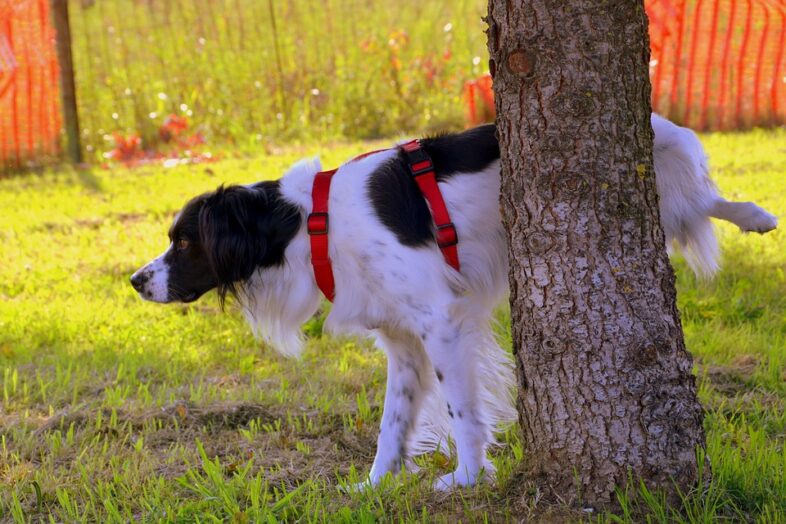These are “Dog Facts Every Dog Owner Should Know – But Which You Would Rather Not” – Such as Dog Urine Sample Collection!
If you are a new dog owner, we bet you never considered any of these matters. With luck you may never encounter the need for the tips which follow!
But the fact is that, there are many things that need consideration by the responsible dog owner, in order to keep your best-friend happy and healthy.
Some of these are aspects of caring for a dog, that perhaps you’d prefer not even think about!
How to Get a Dog Urine Sample
When you go to the vet with an ailing dog, you may be asked to bring along a urine sample from your dog.
New dog owners often question how this is possible?
There isn’t a dog alive that would be able to fill a sample bottle, on demand. But, in reality it is not that hard if you tape an open polythene container to the end of a broom handle.
Watch your dog with the polythene container on the broom handle in your hand and when he, or she, starts doing their business, quickly slide the container into the urine stream.
You’ll get no prizes from guessing that this is easier to do with male dogs than female dogs but with a little practice owners can usually catch a reasonable sample volume after one or two attempts.
Next, keep it refrigerated until you deliver it into the hands of your vet. he or she, will want as fresh a sample as possible. Give it to your vet as soon as possible and take care to keep it refrigerated until you give it to your vet.
Your vet will be routinely checking the sample for a variety of things, but we will concentrate on looking for bacteria and crystals.
Urinary Tract Infection
If bacteria are found in a urine sample, it could indicate that the dog (or puppy) has a urinary tract infection.
If so, that will be most likely to involve putting the animal on a course of antibiotics.
Why did we mention crystals?
Crystals form in the urine whenever several minerals react together.
There are several different kinds of crystals which can form in dogs, like humans, and these are most often treated with prescription diets.
How to Get a Dog Stool Sample
If your vet asks you to bring in a dog stool sample it could mean that he suspects that intestinal parasites are bothering your dog.
Parasites are usually picked up by eating fecal matter from another affected animal, eating carcasses, or other things which have become contaminated. You will want to bring in a freshly collected sample.
The doctor will examine it under the microscope and search for the presence of the telltale eggs of parasite infestation. The commonest parasites seen in dogs, are roundworms, hookworms, whip-worms and tapeworms. Several of today’s monthly heart-worm medications also protect against roundworms and hookworms.
Worming Your Dog
Vets recommend that if you live in the country or your dog is outside for much of the day, he may need to be treated with a worming tablet (“wormed”) on a quarterly basis. Other diseases like coccidia, can also be seen under the microscope when looking at your dog’s stool sample.
Dog Anal Gland Problems
What about anal glands? The anal glands are two small glands located just on the inside of your dogs anus that secrete a foul smelling liquid. Usually the glands will be emptied when your dog defecates.
Unfortunately, in some dogs, the anal glands become impacted and do not empty properly.
If your dog is urinating more than usual or licking his hind quarters more often, there may be a problem with his anal glands.
In this case it’s important to make an appointment with your veterinarian who will check the anal glands by gloved touch. If the anal glands are full, he will be able to empty them manually. it is possible, however, to learn how to do this yourself at home.
Some dogs require their anal glands be manually emptied regularly.
Anal Gland Removal
Some owners have their dog’s anal glands surgically removed but if you choose to do this, discuss the possible outcomes with your vet.
Types of Dog Mange
Occasionally in dogs, dandruff is just dandruff caused by skin allergies, nutritional deficiencies, or improper grooming. Sometimes, however, dandruff can be a sign of a parasite called mange of which there are a few different types:
a) Demodectic Mange is caused by a mite which all dogs have but are rarely adversely affected by it. Sometimes however, there can be an overabundance of these mites which causes skin irritation and hair loss.
b) Sarcoptic Mange (also known as scabies) is caused by another type of mite. A female mite buries herself in the dog’s skin and lays her eggs there. When the eggs hatch, the cycle begins again. This causes severe skin irritation and hair loss in dogs but is easily treatable.
c) Cheyletiella Mange is caused by a large mite that lives on the surface of the dog’s skin. This infestation is also known as ‘walking dandruff’. This type of mange causes minor skin irritation but is easily treatable with topical medication.
So, now you can have been told about those unpleasant things!
It is important that you are properly educated about caring for your dog. Responsible dog-owners will recognize the signs and symptoms of pest infestation and take quick action, when spotted. That way they can keep their dogs as healthy as they can be.



